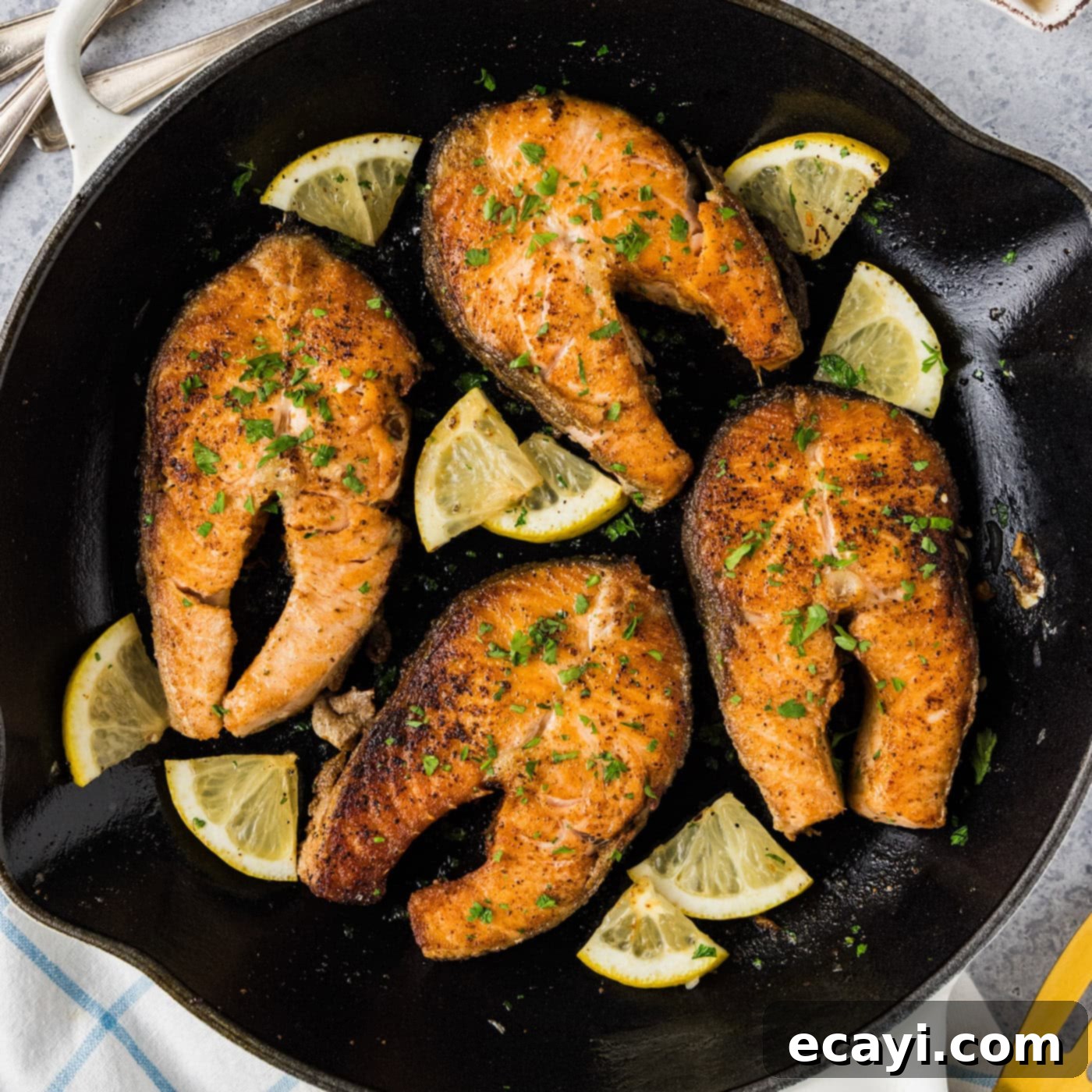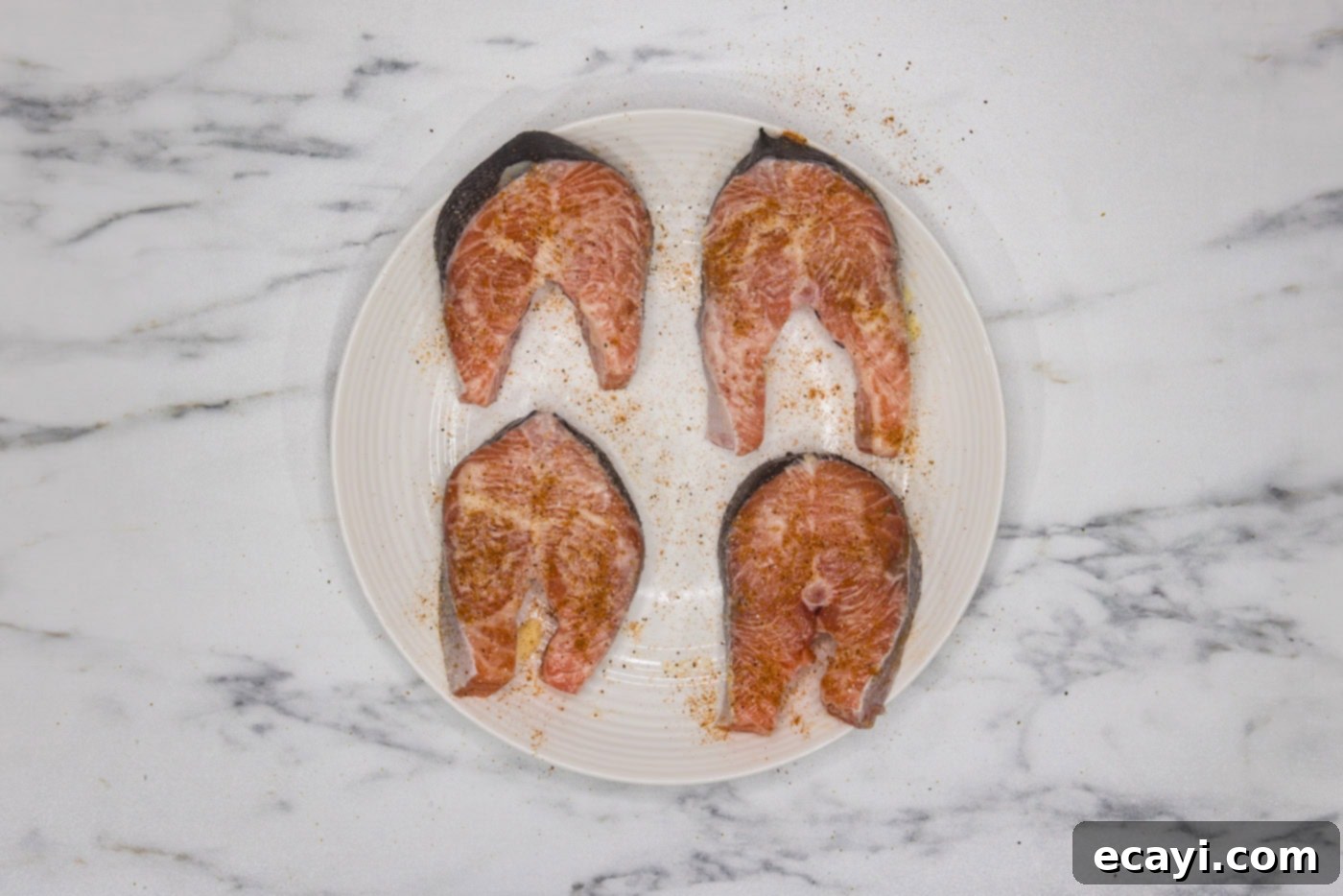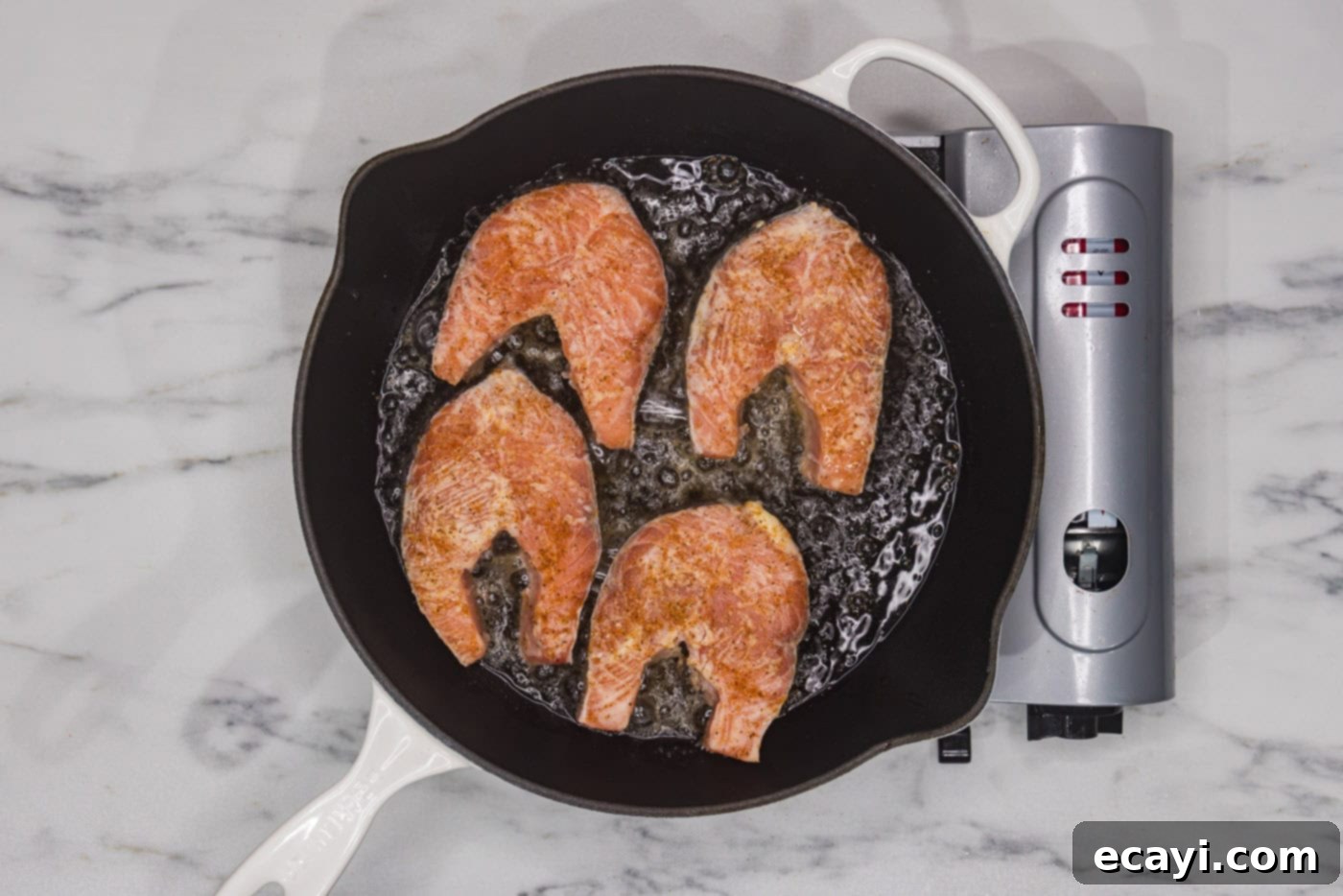Effortlessly Delicious: Pan-Seared Salmon Steaks – Your 15-Minute Guide to Flaky Perfection
Prepare to elevate your weeknight meals with this incredibly simple yet profoundly satisfying pan-seared salmon steaks recipe. In just 15 minutes, you can achieve perfectly tender, flaky, and moisture-rich salmon with a beautiful crispy skin – a true culinary delight that’s both healthy and quick to prepare. Forget complicated cooking techniques; this method relies on a hot skillet and a few key ingredients to bring out the natural, delicious flavors of fresh salmon. Whether you’re a seasoned chef or a kitchen novice, this straightforward recipe promises restaurant-quality results every time, making it an ideal choice for a busy evening or a special, effortless dinner.
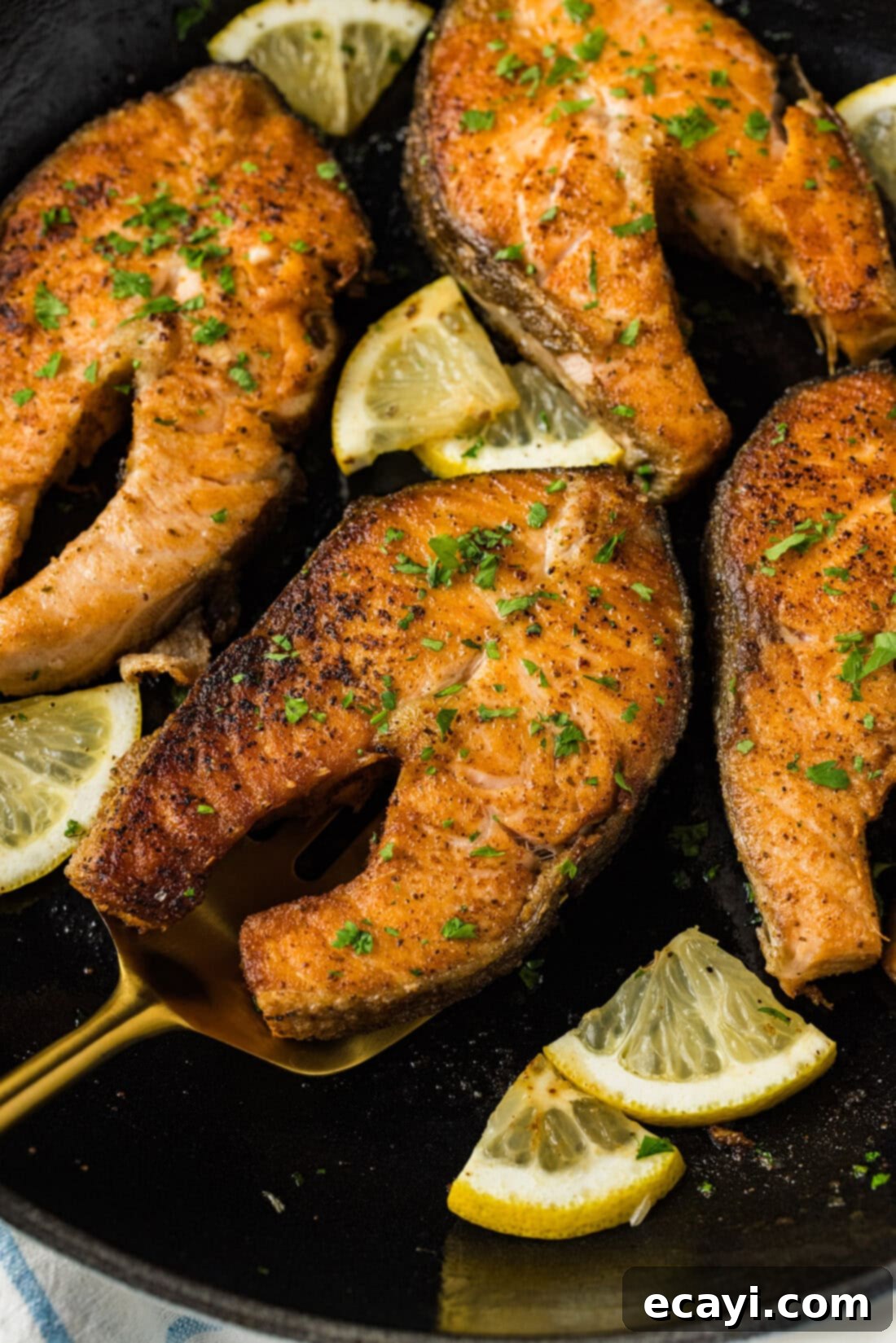
Why This Pan-Seared Salmon Steaks Recipe Is a Must-Try
Salmon steaks, often referred to as the “steak of the seafood world,” offer a unique and delightful dining experience distinct from their fillet counterparts. These cross-cut pieces of fish inherently include the central backbone, which plays a crucial role in the cooking process. This bone acts as a natural heat conductor and helps the steak retain its structural integrity, ensuring the flesh cooks evenly and, most importantly, keeps it incredibly moist and juicy. The result is a supremely tender and flaky texture that’s often harder to achieve with boneless fillets.
The beauty of this recipe lies in its simplicity and efficiency. Cooking these impressive cuts couldn’t be easier, requiring nothing more than a handful of readily available ingredients and a perfectly hot skillet. The pan-searing method is particularly well-suited for salmon steaks because it allows the skin (which is usually present on both sides) to crisp up beautifully to a golden-brown perfection. This creates a delightful textural contrast with the tender, succulent interior, elevating the entire dish. You’ll still get that signature salmon taste – a tad sweet, wonderfully buttery, and packed with vital omega-3 fatty acids – but with an added depth of flavor and a more substantial, satisfying bite compared to a standard fillet.
Beyond the exquisite taste and texture, salmon is celebrated for its incredible health benefits. Rich in protein, vitamins (like B12 and D), and minerals, it’s a powerhouse of nutrition. The high content of omega-3 fatty acids supports heart health, brain function, and reduces inflammation, making this a smart choice for a balanced diet. This recipe not only delivers on flavor but also on nutritional value, making it a win-win for anyone seeking a healthy yet indulgent meal. Its quick cooking time also makes it an excellent option for busy weeknights when you want something impressive without spending hours in the kitchen.
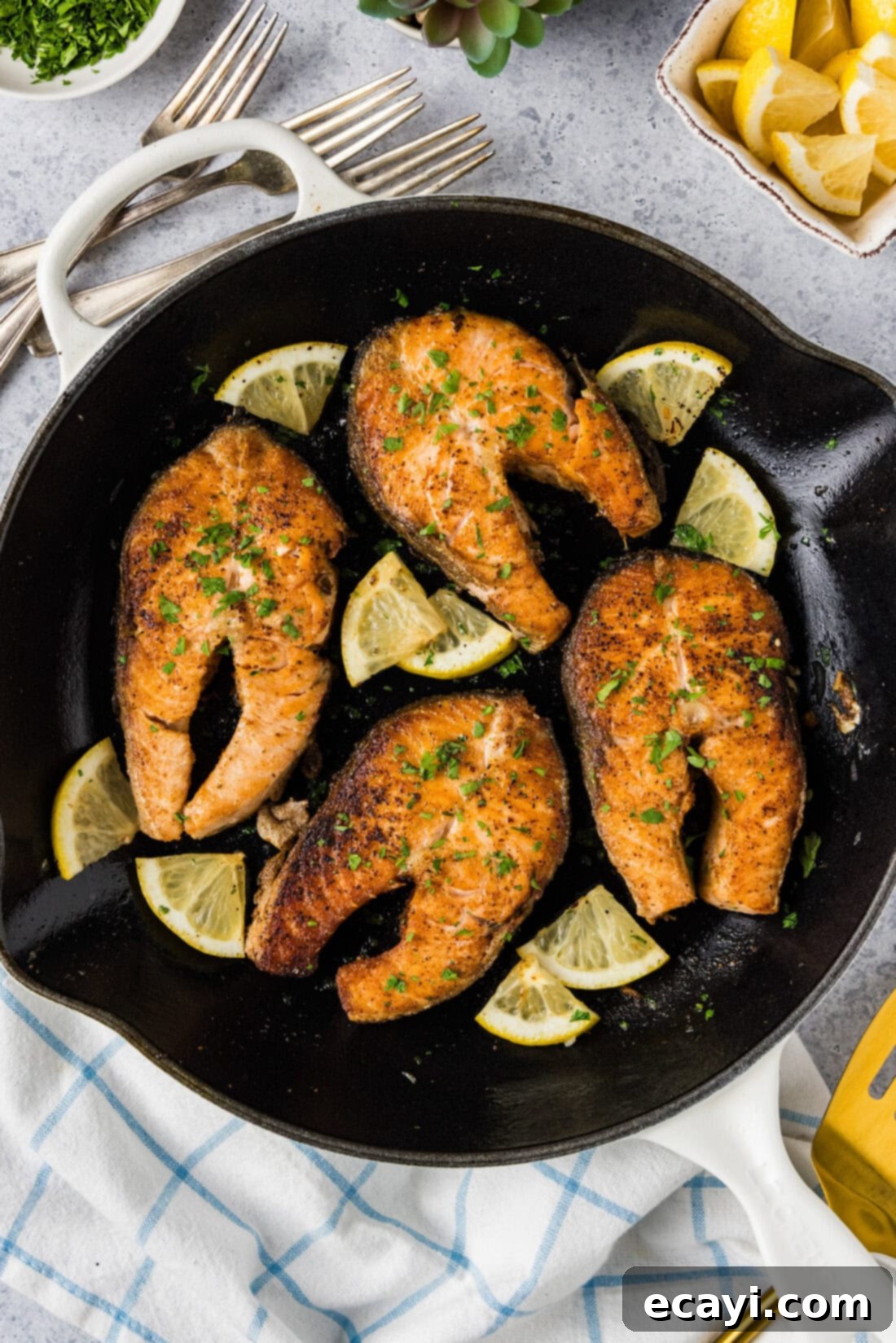
Essential Ingredients for Perfect Pan-Seared Salmon Steaks
Crafting these delectable salmon steaks requires only a few high-quality ingredients, emphasizing that less is often more when it comes to bringing out natural flavors. The beauty of this recipe lies in its simplicity, allowing the inherent richness of the salmon to truly shine through. For precise measurements, detailed instructions, and a convenient printable version of this recipe, please refer to the dedicated recipe card located at the very end of this comprehensive guide.
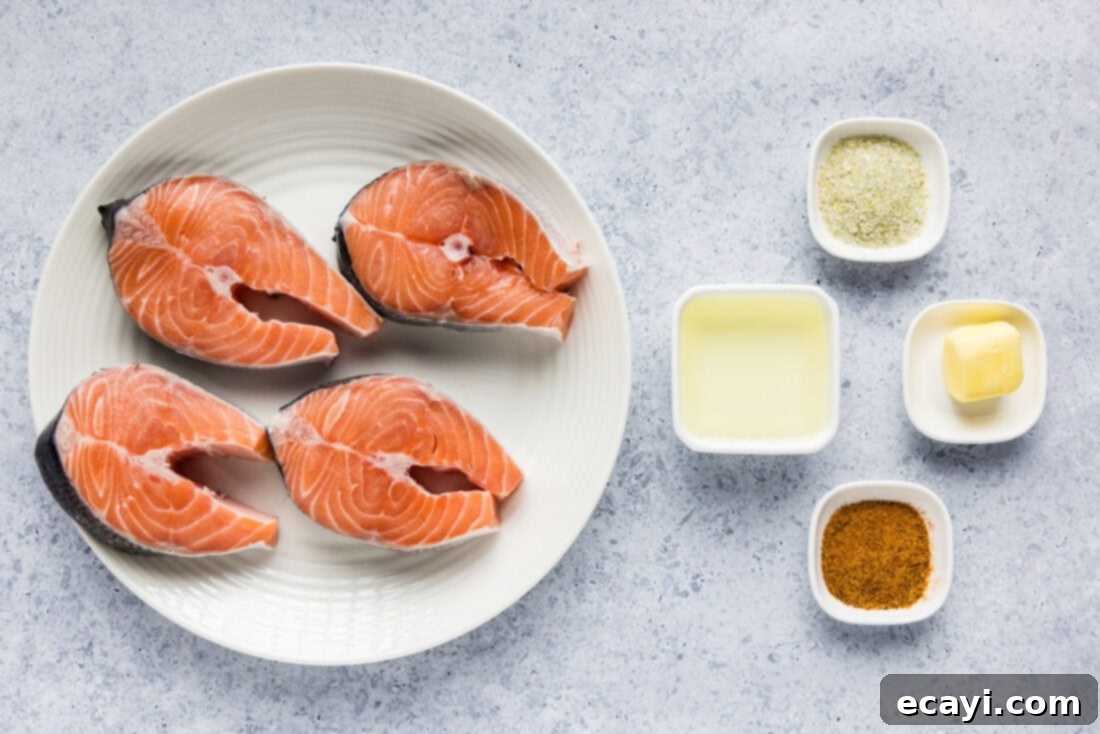
Ingredient Spotlight & Expert Substitution Suggestions
Selecting the Best Salmon Steaks
SALMON – The cornerstone of this exceptional dish. Salmon steaks are distinctive cross-sections of the fish, characterized by the central bone and often skin on both sides. This particular cut contributes to a remarkably moist and flavorful result during cooking. When sourcing, look for salmon with vibrant, firm flesh and a fresh, ocean-like aroma – steer clear of any strong “fishy” smells. If your local grocery store doesn’t typically display salmon steaks, don’t hesitate to ask the seafood counter or meat department. Many stores are more than happy to custom-cut them for you; we’ve frequently ordered them a day in advance with great success. Both wild-caught and farmed salmon varieties work beautifully here, with wild often offering a slightly firmer texture and richer flavor, while farmed can be more consistently buttery.
Optimal Seasonings for Flavor
SEASONINGS – For perfectly seasoned salmon that highlights its natural taste, a blend of garlic salt and Old Bay seasoning is truly all you need. Garlic salt provides a foundational savory depth with a hint of allium, while Old Bay seasoning adds that iconic, aromatic kick – a classic seafood spice blend with notes of celery salt, paprika, and a unique blend of other spices. This combination enhances the salmon without overwhelming its delicate flavor. However, feel free to personalize your seasoning! Other excellent options include fresh dill, lemon pepper, smoked paprika, or a simple sprinkle of flaky sea salt and freshly cracked black pepper. If you intend to serve your salmon with a robust sauce, a lighter touch with seasonings allows the sauce to become the star of the show.
Enhancing with Garnishes & Sauces
GARNISH – While these pan-seared salmon steaks are incredibly delicious on their own, a complementary sauce or garnish can truly elevate the meal. I personally adore serving my salmon with a flavorful accompaniment. I highly recommend trying our classic salmon sauce for a creamy and tangy addition, or a bright, zesty lemon cream sauce to cut through the richness. For an aromatic, herbal note, our rosemary cream sauce is fantastic, and for a vibrant, fresh, and slightly spicy kick, chimichurri makes an excellent choice with these juicy fish steaks. Even a simple squeeze of fresh lemon juice before serving can brighten and enhance all the flavors, offering a perfect acidic balance.
How to Perfectly Pan-Sear Salmon Steaks
These step-by-step photos and detailed instructions are provided to help you visualize each stage of the cooking process, ensuring you achieve a flawless and delicious result. For your utmost convenience, you can easily Jump to Recipe to access the complete printable version of this recipe, featuring all precise measurements and instructions located at the bottom of this page.
- Prepare the Salmon Steaks for Searing: Begin by thoroughly patting your salmon steaks dry on all sides using paper towels. This is a critical step for achieving that highly desired crispy skin. Next, generously brush melted butter evenly over both sides of each salmon steak. The butter not only imparts a rich flavor but also helps the seasonings adhere beautifully to the fish. Proceed to season each side uniformly with garlic salt and a good amount of Old Bay seasoning. Ensure an even, flavorful coating, as this forms the base of your delicious crust.

- Heat Your Skillet to Perfection: Place a large, heavy-bottomed skillet (cast iron or a quality stainless steel pan are excellent choices for even heat distribution) over medium-high heat. Add the olive oil and allow it to heat until it just begins to shimmer and faint wisps of smoke appear. This visual cue indicates the oil is hot enough to create an immediate, beautiful crust on the salmon without it sticking. A properly heated pan is paramount for a successful pan-sear.
- The First Sear – Developing the Crispy Skin: Carefully place the seasoned salmon steaks, skin-side down (if only one side has skin, start with that side), into the hot skillet. Be sure not to overcrowd the pan; if necessary, cook in batches to maintain the high temperature. Allow the salmon to cook undisturbed for precisely 4 minutes. It’s crucial to resist the urge to move, poke, or peek at the steaks during this initial searing phase, as this is when the magnificent crispy crust forms. You’ll observe the edges of the salmon begin to turn opaque and develop a beautiful golden hue.

- The Second Sear & Resting: With utmost care, use a sturdy fish spatula to gently turn the salmon steaks over to the other side. Continue to cook for an additional 3 minutes. For thicker salmon steaks, you may need to extend the cooking time by an extra minute or two, always keeping in mind that salmon cooks relatively quickly. The ultimate goal is a flaky, tender interior that remains wonderfully moist. Once the salmon reaches your desired doneness (refer to the FAQ for temperature guidelines), remove it immediately from the skillet and allow it to rest for a few minutes on a plate. This brief resting period is vital, as it allows the juices to redistribute throughout the fish, guaranteeing maximum tenderness and flavor.
Frequently Asked Questions & Expert Tips for Salmon Steaks
Salmon steaks are distinct cross-cut pieces of the fish, typically sliced perpendicular to the spine, meaning they include a portion of the central backbone and usually have skin on both sides. This makes them thicker, more substantial, and heartier cuts. The bone acts as an insulator and heat conductor during cooking, which helps the steak retain moisture and results in a juicier, more tender texture. In contrast, salmon fillets are cut lengthwise from the side of the fish, are typically boneless, and usually have skin on only one side (or no skin at all). Fillets are generally more delicate, cook faster, and are often preferred for their ease of preparation and portioning. Salmon steaks are ideal for those who appreciate a robust piece of fish with a unique texture, while fillets offer greater versatility for various cooking methods.
Ensuring your salmon is perfectly cooked without overdoing it is key to a delicious meal. The most straightforward visual test is to gently flake the thickest part of the flesh with a fork; it should separate easily and appear opaque throughout. However, for guaranteed precision, I highly recommend using an instant-read thermometer. Insert the thermometer into the thickest part of the salmon steak, making sure to avoid touching the bone, as this can give an inaccurate reading. The ideal internal temperature for medium-cooked salmon is around 140°F (60°C), which yields a moist, slightly translucent center. For well-done salmon, the temperature should reach 145°F (63°C). Always remember that salmon, like other proteins, undergoes carryover cooking after being removed from the heat. To achieve the juiciest results, I typically pull mine out when it reaches about 140°F and let it rest for a couple of minutes, allowing it to finish cooking to perfection.
To keep your cooked salmon steaks fresh and delicious, allow them to cool completely to room temperature after cooking. Once cooled, transfer them to an air-tight container and store them in the refrigerator for up to 3-4 days. When it comes to reheating salmon, it’s notoriously easy to overcook and dry it out. To maintain its moisture and flaky texture, I suggest reheating it gently. Place the salmon in a covered skillet over low heat with a splash of water or a tiny amount of broth. This creates a steamy environment that warms the fish through without drying it, typically taking about 5 minutes. Alternatively, you can reheat it in a preheated oven at a low temperature, around 275°F (135°C), for 10-15 minutes, or until it’s just warmed through to your liking.
For achieving the best possible sear and a truly crispy skin, a heavy-bottomed skillet that retains heat exceptionally well is paramount. Cast iron skillets are highly recommended for pan-searing salmon. They distribute heat very evenly across the cooking surface and maintain a consistent high temperature, which is crucial for forming that desirable crust. High-quality stainless steel skillets are also an excellent alternative if properly preheated. While non-stick pans can be used, a well-seasoned cast iron or a good stainless steel pan will generally yield a superior, more robust sear and a crispier skin due to their heat retention properties. Ensure your chosen skillet is large enough to accommodate your salmon steaks without overcrowding, allowing each piece to make direct contact with the hot surface.
Whether to keep the skin on or remove it is ultimately a matter of personal preference. However, for pan-seared salmon steaks, I enthusiastically recommend keeping the skin on! When prepared correctly, the salmon skin becomes incredibly crispy and intensely flavorful, adding a wonderful textural dimension to the dish that many find delightful. Furthermore, the skin acts as a natural protective barrier for the delicate flesh of the salmon, helping to prevent it from drying out during the high-heat cooking process. If you decide you prefer your salmon without skin, it can be easily removed after cooking once it has crisped up. But for the full pan-seared experience, embrace the crispy skin!
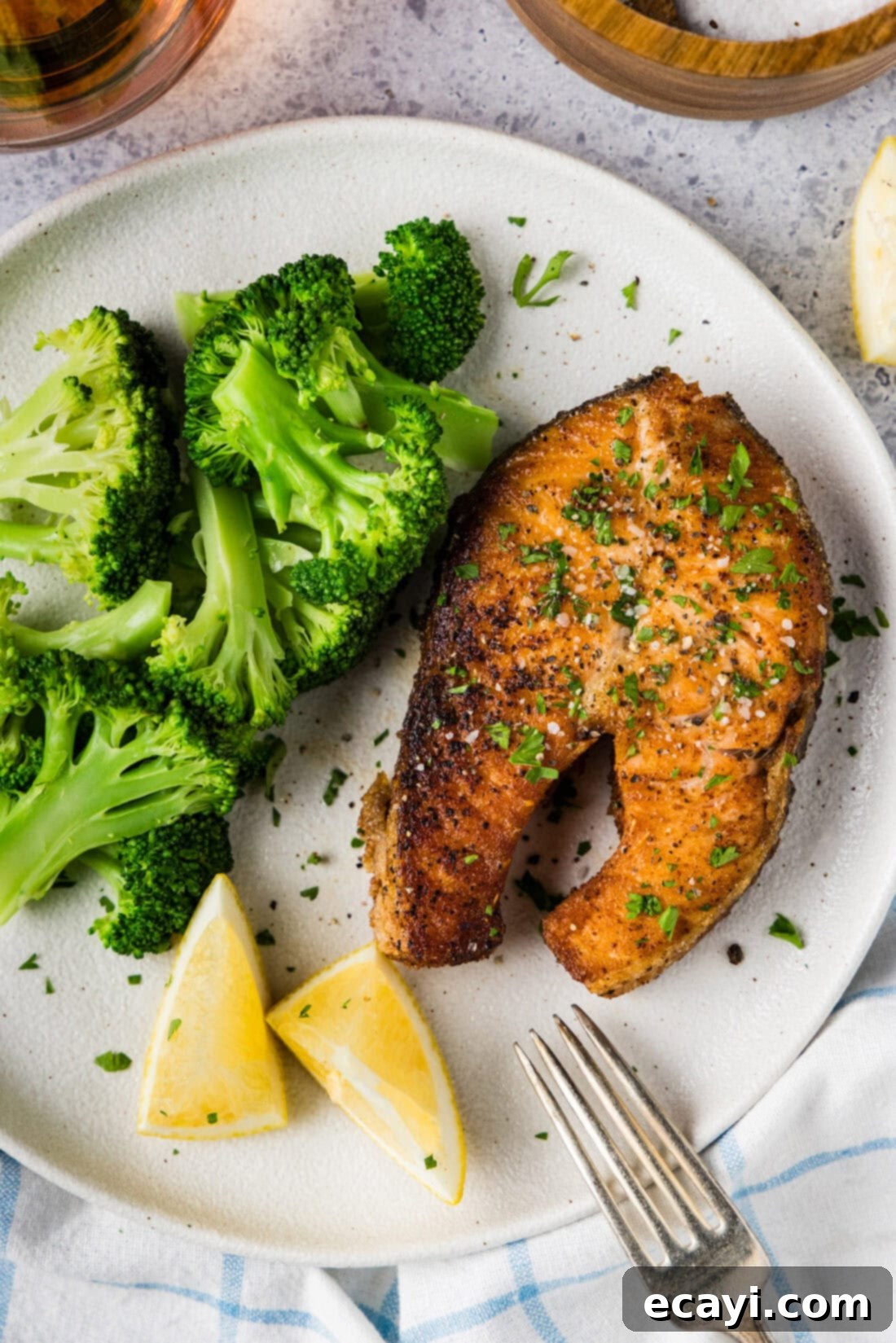
Delicious Serving Suggestions for Your Salmon Steaks
These perfectly pan-seared salmon steaks are incredibly versatile and pair beautifully with a wide array of side dishes, allowing you to create a complete and balanced meal for any occasion. For a light yet elegant accompaniment, consider serving them alongside your favorite roasted or steamed vegetables. Options like tender asparagus, crisp green beans, or vibrant broccoli florets offer a lovely textural contrast to the rich, flaky salmon. A simple drizzle of olive oil, a sprinkle of salt and pepper, and a quick roast are all they need.
If you’re looking for something more substantial to round out your plate, creamy garlic mashed potatoes provide a comforting and rich base that beautifully soaks up any flavorful pan drippings or sauces. Alternatively, for a lighter and zestier option, a fluffy lemon couscous or a quinoa salad infused with fresh herbs would be fantastic choices. A fresh garden salad with a bright vinaigrette is also an excellent way to cut through the richness of the fish. And don’t forget the essential fresh lemon wedge – a squeeze of citrus just before serving is a simple yet impactful way to brighten and enhance the flavors of any seafood dish.
Explore More Delicious Salmon Recipes
If you’re a devoted fan of salmon and constantly seeking new and exciting ways to enjoy this incredibly nutritious and flavorful fish, then you’ve come to the right place! Be sure to delve into these other fantastic and diverse salmon recipes from our culinary collection. Each offers a unique approach to preparing salmon, promising variety and delicious results:
- Spicy Salmon – Perfect for those who crave a vibrant kick and a bit of heat with their seafood.
- Baked Salmon – A wonderfully hands-off method that guarantees tender, moist results with minimal fuss.
- Maple Soy Salmon – An irresistible blend of sweet and savory flavors, creating a beautiful glaze and a truly addictive dish.
- Brown Sugar Salmon – A delightfully caramelized and deeply flavorful recipe that’s sure to impress.
I absolutely love spending time in the kitchen, experimenting with new flavors, and sharing my culinary experiences with all of you! Remembering to come back each day for new inspiration can sometimes be a challenge, which is why I offer a convenient newsletter delivered right to your inbox every time a new recipe is published. Simply subscribe here and start receiving your free daily recipes, tips, and tricks directly!
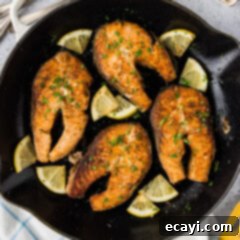
Pan-Seared Salmon Steaks
IMPORTANT – Don’t miss our detailed Frequently Asked Questions and Expert Tips sections within the blog post! Scroll up to read them for additional insights and cooking advice that will help you master this recipe.
Print It
Pin It
Rate It
Save ItSaved!
Ingredients
- 4 salmon steaks about 1 1/2 pounds, bone-in, skin-on
- 2 Tablespoons butter melted
- garlic salt to taste
- Old Bay seasoning to taste
- ⅓ cup olive oil
Tools You’ll Need
-
Large skillet
-
Instant-read thermometer
Before You Begin & Key Notes
- Sourcing Salmon Steaks: If your grocery store doesn’t typically carry salmon steaks, don’t hesitate to inquire at the meat or seafood counter. Many stores can custom-cut them for you, often with a day’s notice.
- Achieving Doneness: The easiest way to check if your salmon is perfectly cooked is by gently flaking the thickest part with a fork. It should separate easily and look opaque throughout. For precise results, use an instant-read thermometer inserted into the thickest portion (avoiding the bone). Aim for 140°F (60°C) for medium doneness or 145°F (63°C) for well-done. Remember, salmon continues to cook for a few minutes after being removed from the heat.
- Resting Time: After cooking, let your salmon steaks rest on a plate for 2-3 minutes. This allows the juices to redistribute, ensuring a more tender and flavorful fish.
- Crispy Skin Secret: Always pat the salmon skin very dry before seasoning and searing. This is crucial for achieving that irresistible crispy texture.
Instructions
-
Pat the salmon steaks dry with paper towels. Brush both sides generously with melted butter. Season evenly with garlic salt and Old Bay seasoning.4 salmon steaks, 2 Tablespoons butter, garlic salt, Old Bay seasoning
-
Heat the olive oil in a large skillet over medium-high heat until it shimmers. This usually takes about 2-3 minutes.1/3 cup olive oil
-
Carefully place the seasoned salmon steaks into the hot skillet. Cook undisturbed for 4 minutes to achieve a golden, crispy skin. Avoid moving them during this initial sear.
-
Gently flip the steaks over using a spatula. Continue to cook for another 3 minutes, or until the salmon reaches your desired doneness (140-145°F internal temperature). Remove from heat and let rest for a few minutes before serving.
Expert Tips & Reheating Guide
- Leftover Storage: Store any cooled leftover salmon steaks in an air-tight container in the refrigerator for up to 3-4 days to maintain freshness.
- Gentle Reheating: To prevent drying out, reheat salmon gently. Place in a covered skillet over low heat with a tablespoon of water or broth, and warm through for about 5 minutes, or until just heated. Alternatively, use a low oven temperature (275°F/135°C) for 10-15 minutes.
- Don’t Overcrowd the Pan: Cooking too many steaks at once can lower the pan’s temperature, leading to steaming instead of searing. Cook in batches if necessary.
- Use Fresh Lemon: A squeeze of fresh lemon juice just before serving brightens all the flavors and adds a touch of acidity that perfectly complements rich salmon.
Nutrition Information
Please note: The recipes on this blog are typically tested using a conventional gas oven and stovetop. Oven and appliance performance can vary, especially with age, so an inexpensive oven thermometer can be a valuable tool to ensure accurate temperatures. If using a toaster oven, countertop oven, or other specialized appliances like a pressure cooker, air fryer, or slow cooker, cooking times and heat distribution may differ. Adjustments to cooking/baking times might be necessary. For baking recipes that provide measurements by weight, we strongly recommend adhering to those for the best results, as cup measurements can sometimes lead to inconsistencies. We cannot guarantee success if different measurement methods are used.
